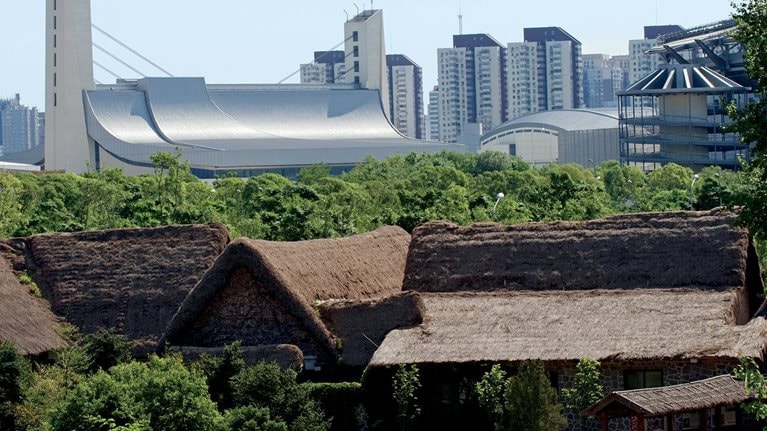Our rapidly urbanizing world faces an enormous demographic imbalance. Over the next few decades, Europe, and to some extent the United States and China, will be aging and shrinking, even as India, Africa, and the Middle East see their populations expanding. At the same time, we still have three billion people in the world who have no access to water, electricity, health care, and education. And we are moving from a global population of seven billion to nine billion.
Clearly cities are the key to whether we successfully meet this massive transition challenge and achieve growth that is both sustainable and inclusive. And the critical enabler is going to be technology. What was once a visionary notion is now the new normal: technology is really as essential as the three utilities—water, gas, and electricity. If you want to revitalize an old city, or if you are erecting a new greenfield city, technology has to be built in. Today many leading cities have a ten-year plan that includes a master information and communication technology (ICT) plan. A city without an ICT master plan is simply not relevant anymore.
The goal, of course, is to view technology as part of a holistic, services-oriented approach to revitalizing cities. Right now, in most places, whether you move into a new apartment or buy an old one, you have to rip the ceiling out to get wireless in and buy various devices. But imagine what would happen if everywhere you went, as with electricity or water, that technology were simply built in? Suddenly the only thing to worry about would be how to provide the new services that consumers will increasingly demand: assisted living for the older population, safety and security, parking services, medical services (we already know that 80 percent of doctor visits don’t require physical interaction), and access to public services in general. When you get to a critical mass, the data on the benefits is so compelling: a 50 percent reduction over a decade in energy consumption, a 20 percent decrease in traffic, an 80 percent improvement in water usage, a 20 percent reduction in crime rates. The concept of smart cities really sells itself.
How can we accelerate this transition? Here’s a statistic that underscores both the problem and the potential: worldwide spending on infrastructure and construction is about $2 trillion a year, and ICT spending is just 1.5 to 2 percent of that. But over the next decade, we will continue with advances in cloud computing, big data, and open data, and we will see 50 billion devices connected through machine-to-machine communication, which will foster the industrialization of the Internet. Intel predicts that in a decade, the Internet of Things will be a $1.5 trillion-a-year business—just from a technology point of view. But on top of that there will be another $2 trillion annually in new services. So we don’t need to increase ICT’s share of global infrastructure spending from today’s levels to reap the benefits. We just need to ensure that our investments are smarter and move technology from being an afterthought to having it embedded in our urban master plans.
That said, we still face huge hurdles. Politicians face short-term election cycles, while the benefits of this kind of investment are longer term. Hence, in addition to articulating the vision for their cities, politicians need to score quick wins and generate budgets for the parts of their vision that demonstrate immediate benefits. Construction is one of the world’s most conservative industries. It’s the only vertical industry that hasn’t really made any productivity improvements over the last 30 years. There are too few global standards. Look at electricity with the longstanding variation between 110 and 220 volts and multiple outlets. We still can’t agree on a common standard. We need better protocols and global open standards, like those that enabled the growth and connectivity of the Internet. We need to create new ecosystems, in effect whole new industries to enable some of these benefits. Consider parking. In Paris, as in many cities, the average citizen spends four years of his life trying to find a parking place. But what if you could drive in off the highway, and your navigation system would guide you to a free parking place? It would reduce congestion and carbon emission. That is beginning to happen in cities like San Francisco and Chicago. But getting these projects off the ground requires the right regulatory framework and collaboration among a lot of industries in order to provide everything from the sensors in the street to the apps in your car or mobile device.
Happily we are starting to see real success stories. In every case, success requires five elements. First, thought leadership. Without a mayor with a long-term vision and passion, you are simply not going to get there. Second, you need smart regulation that updates standards for the 21st century and creates positive incentives for change. For example, in Australia, regulation requires every building to have a water tank under it to store water—even in buildings that are water-usage neutral, which is simply a waste of resources. San Francisco uses Urban EcoMap, an Internet-based tool that provides its citizens with information on carbon emissions from transportation, energy, and waste among neighborhoods, organized by zip codes. The tool helps them to make sustainability part of their decision making. Third, we need global open standards. Fourth, we need public-private partnerships, which offer a way around that short-term election-cycle trap by leveraging public goods to foster private investment, save money, and create new long-term benefits. In Chicago, for example, Mayor Rahm Emanuel has created an infrastructure trust, and he is asking private companies to come in, invest, and get concessions for 10 or 20 years to operate facilities.
Others are making great strides by transforming big data into open data. In Washington, Apps for Democracy, a not-for-profit organization created by Mayor Vincent C. Gray, is an open community platform developed for submitting 311 (non-emergency) service requests to the city. The first edition of Apps for Democracy yielded 47 Web, iPhone, and Facebook apps in 30 days—a $2,300,000 value to the city at a cost of $50,000.
That brings me to the fifth element, which is creating new ecosystems—bringing four to five companies together, inspired by a government initiative, to solve a big problem. Europe is leading the way, especially when it comes to revitalizing older cities. The economic regeneration of Barcelona is one of the largest transformational projects under way in Europe at the moment. The city’s revitalization agenda has so far created 45,000 jobs and attracted around 1,500 new companies. In Amsterdam there are more than 100 Smart Work Centers that offer high-end working facilities and aim to reduce travel and promote efficient and sustainable ways of working. These Smart Work Centers are a showcase of the future of work and virtualization.
How different will the world be in 20 years as all this plays out? I think about how my own life has changed. I was 12 when we got a black-and-white television at home. I was 20 when I took my first plane ride; 30 when I got my first cell phone. I was 40 when I used my first VPN connection and 50 when I first used video conferencing over TelePresence. My ten-year-old son wanted a mobile phone, and when I told him he had been too young, he asked me how old I had been. End of argument. He cannot imagine that I lived 30 years without a cell phone. If I’m not careful, I can become a prisoner of my own experiences, and then I won’t think outside the box. With the pace of change accelerating, we’re likely to hit new inflection points even faster.
While cities will play an ever-increasing role, just think about how technology as an enabler is already affecting rural life. Today in India people often have access to ICT before they have water or electricity. One of the most used apps in rural areas there is to make your cell phone a lamp, because there’s no electricity. During the day you can recharge it via a solar panel in the village. And that is, in turn, leapfrogging access to health care, education, and eventually work. Technology will empower diverse demographics across continents. Right now, there are illiterate people in rural India doing video surveillance for retail stores in the United States. They can observe and press a button if they see strange behavior.
Now imagine what’s ahead as we continue to improve our connectivity and move from five billion people with cell phones to seven billion. As technology enables a host of new services over common platforms, we’re going to see whole new industries arise and new waves of innovation. The future of competition will be among cities, and the ones that thrive will be those that have overall sustainability—economic, social, and environmental. From a sustainability point of view, it’s a good thing for the planet. And it’s probably the only way out.

